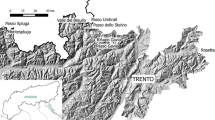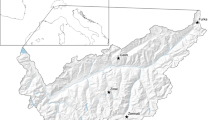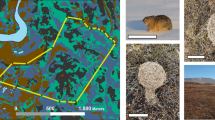Abstract
Pink-footed geese Anser brachyrhynchus nest in two contrasting but commonly found habitats: steep cliffs and open tundra slopes. In Svalbard, we compared nest densities and nesting success in these two environments over ten breeding seasons to assess the impact of spring snow cover, food availability to nesting adults and arctic fox Vulpes lagopus (main terrestrial predator) abundance. In years with extensive spring snow cover, fewer geese at both colonies attempted to breed, possibly because snow cover limited pre-nesting feeding opportunities, leaving adults in poor breeding condition. Nesting success at the steep cliff colony was lower with extensive spring snow cover; such conditions force birds to commit to repeated and prolonged recess periods at far distant feeding areas, leaving nests open to predation. By contrast, nesting success at the open tundra slope was not affected by spring snow cover; even if birds were apparently in poor condition they could feed immediately adjacent to their nests and defend them from predators. Foxes were the main nest predator in the open tundra slopes but avian predators likely had a larger impact at the steep cliffs colony. Thus, the relative inaccessibility of the cliffs habitat may bring protection from foxes but also deprives geese from readily accessing feeding areas, with the best prospects for successful nesting in low spring snow cover years. Our findings indicate that spring snow cover, predator abundance and food proximity did not uniformly influence nesting success of this herbivore, and their effects were dependent on nesting habitat choice.



Similar content being viewed by others
References
Anderson HB, Godfrey TG, Woodin SJ, Van der Wal R (2012) Finding food in a highly seasonal landscape: where and how pink-footed geese Anser brachyrhynchus feed during the Arctic spring. J Avian Biol 43:415–422
Ankney CD, MacInnes CD (1978) Nutrient reserves and reproductive performance of female lesser snow geese. Auk 95:459–471
Arzel C, Elmberg J, Guillemain M (2006) Ecology of spring-migrating Anatidae: a review. J Ornithol 147:167–184
Black JM, Owen M (1995) Reproductive performance and assortative pairing in relation to age in barnacle geese. J Anim Ecol 64:234–244
Davis JB, Kaminski RM, Stephens SE (1998) Wood duck eggshell membranes predict duckling numbers. Wildl Soc B 26:299–301
Eide NE, Jepsen JU, Prestrud P (2004) Spatial organization of reproductive Arctic foxes Alopex lagopus: responses to changes in spatial and temporal availability of prey. J Anim Ecol 73:1056–1068
Eide NE, Eid PM, Prestrud P, Swenson JE (2005) Dietary responses of arctic foxes Alopex lagopus to changing prey availability across and Arctic landscape. Wildl Biol 11:109–121
Eide NE, Stein A, Prestrud P, Yoccoz NG, Fuglei E (2012) Reproductive responses to spatial and temporal prey availability in a coastal Arctic fox population. J Anim Ecol 81:640–648
Forslund P, Larsson K (1992) Age-related reproductive success in the barnacle goose. J Anim Ecol 61:195–204
Fox AD, Francis IS, Bergersen E (2006) Diet and habitat use of Svalbard pink-footed geese Anser brachyrhynchus during arrival and pre-breeding periods in Adventdalen. Ardea 94:691–699
Frafjord K (1990) A study of the pink-footed goose in Gipsdalen, Svalbard, during the pre-breeding and early breeding periods. In: Severinsen T, Hansson R (eds) Environmental Atlas Gipsdalen, Svalbard Vol. III. Reports on the Fauna of Gipsdalen, Norsk Polarintitutt Rapport nr. 66, Norwegian Polar Institute, Olso, pp 1–18
Frafjord K (1993) The arctic fox as a predator on the Svalbard pink-footed goose. Fauna 46:10–14
Fuglei E (2006) Arctic fox. In: Kovacs KM, Lydersen C (eds) Birds and mammals of Svalbard. Norsk Polarintitutt, Oslo, pp 77–80
Glahder CM, Fox AD, Hübner CE, Madsen J, Tombre IM (2006) Pre-nesting site use of satellite transmitter tagged Svalbard Pink-footed Geese Anser brachyrhynchus. Ardea 94:679–690
Gunnarsson TG, Gill JA, Newton J, Potts PM, Sutherland WJ (2005) Seasonal matching of habitat quality and fitness in a migratory bird. Proc R Soc B 272:2319–2323
Heppleston PB (1972) The comparative breeding ecology of oystercatchers (Haematopus ostralegus L.) in inland and coastal habitats. J Anim Ecol 41:23–51
Inglis IR (1977) The breeding behaviour of the pink-footed goose: behavioural correlates of nesting success. Anim Behav 25:747–764
Jepsen JU, Eide NE, Prestrud P, Jacobsen LB (2002) The importance of prey distribution in habitat use by arctic foxes (Alopex lagopus). Can J Zool 80:418–429
Johnson DH, Shaffer TL (1990) Estimating nest success: when Mayfield wins. Auk 107:595–600
Klaassen M, Abraham KE, Jefferies RL, Vrtiska M (2006) Factors affecting the site of investment, and the reliance on savings for arctic breeders: the capital-income dichotomy revisited. Ardea 94:371–384
Løvenskiold HL (1964) Avifauna Svalbardensis. Nor Polarinst Skr 129:125–134
Madsen J, Bregnballe T, Hastrup A (1992) Impact of the arctic fox Alopex lagopus on nesting success of geese in southeast Svalbard, 1989. Polar Res 11:25–39
Madsen J, Bregnballe T, Frikke J, Kristensen JB (1998) Correlates of predator abundance with snow and ice conditions and their role in determining timing of nesting and breeding success in Svalbard light-bellied brent geese Branta bernicla hrota. In: Mehlum F, Black JM, Madsen J (eds) Research on Arctic Geese. Proceedings of the Svalbard Goose Symposium, Oslo, Norway, 1997. Norsk Polarinstitutt Skr 200, Norsk Polarinstitutt, Oslo, pp 221–234
Madsen J, Tamstorf M, Klaassen M, Eide N, Glahder C, Rigét F, Nyegaard H, Cottaar F (2007) Effects of snow cover on the timing and success of reproduction in high-Arctic pink-footed geese Anser brachyrhynchus. Polar Biol 30:1363–1372
Madsen J, Tombre I, Eide NE (2009) Effects of disturbance on geese in Svalbard: implications for regulating increasing tourism. Polar Res 28:376–389
Meltofte H, Piersma T, Boyd H, McCaffery B, Ganter B, Golovnyuk VV, Graham K, Gratto-Trevor CL, Morrison RIG, Nol E, Rösner HU, Schamel D, Schekkerman H, Soloviev MY, Tomkovich PS, Tracey DM, Tulp I, Wennerberg L (2007) Effects of climate variation on the breeding ecology of Arctic shorebirds. Meddelelser om Grønland 59:1–48
Meltofte H, Høye TT, Schmidt NM (2008) Effects of food availability, snow and predation on breeding performance of waders at Zachenberg. Adv Ecol Res 40:325–342
Nyholm ES (1965) Ecological observations on the geese of Spitsbergen. Ann Zool Fenn 2:197–207
Piechura J, Walczowski W (2009) Warming of the west Spitsbergen current and sea ice north of Svalbard. Oceanologia 51:147–164
Prestrud P (1992) Food habitats and observations of the hunting behaviour of arctic foxes, Alopex lagopus, in Svalbard. Can Field Nat 106:225–236
Prop J, de Vries J (1993) Impact of snow and food conditions on the reproductive performance of barnacle geese (Branta leucopsis). Ornis Scand 24:110–121
Prop J, Oudman T, Van Spanje TM, Wolters EH (2013) Patterns of predation of pink-footed goose nests by polar bear. Ornis Nor 36:38–46
Raveling DG (1979) The annual cycle of body composition of Canada geese with special reference to control of reproduction. Auk 96:234–252
Samelius G, Alisauskas RT (2006) Sex-biased costs in nest defence behaviours by lesser snow geese (Chen caerulescens): consequences of parental roles? Behav Ecol Sociobiol 59:805–810
Semmens KA, Ramage J, Bartsch A, Liston GE (2013) Early snowmelt events: detection, distribution, and significance in a major sub-arctic watershed. Environ Res Lett 8, article no. 014020. doi:10.1088/1748-9326/8/1/014020
Sigurdsson JB (1974) Studies on breeding biology of pink-footed geese (Anser brachyrhynchus). In: Sigurdsson JB, Gardarsson A (eds) Skýrsla um rannsóknir I þjórsárverum 1972. Orkustofnun Raforkudeild, Reykjavik, pp 1.2–1.39
Spaans B, Van der Veer W, Ebbinge BS (1999) Cost of incubation in a greater white-fronted goose. Waterbirds 22:151–155
Spaans B, Van’t Hoff CA, Van der Veer W, Ebbinge BS (2007) The significance of female body stores for egg laying and incubation in dark-bellied brent geese Branta bernicla bernicla. Ardea 95:3–15
Speed JDM, Woodin SJ, Tømmervik H, Tamstorf MP, Van der Wal R (2009) Predicting habitat utilization and extent of ecosystem disturbance by an increasing herbivore population. Ecosystems 12:349–359
Tombre IM, Mehlum F, Loonen MJJE (1998) The Kongsfjorden colony of barnacle geese: nest distribution and the use of breeding islands 1980–1997. In: Mehlum F, Black JM, Madsen J (eds) Research on Arctic Geese. Proceedings of the Svalbard Goose Symposium, Oslo, Norway, 1997. Norsk Polarinstitutt Skr 200, Norsk Polarintitutt, Oslo, pp 57–65
Wisz MS, Tamstorf MP, Madsen J, Jespersen M (2008) Where might the western Svalbard tundra be vulnerable to pink-footed goose (Anser brachyrhynchus) population expansion? Divers Distrib 14:26–37
Acknowledgments
We thank Juliet Blum, Malcolm Parsons and Troels Hastrup for contributions to data collection in the field. We are indebted to Christiaane Hübner for her considerable help before, during and after fieldwork. Norwegian Polar Institute supplied vital logistic support and the Governor of Svalbard allowed access to Sassendalen. Part of this work was undertaken, while HBA was in receipt of a studentship from the College of Life Science and Medicine, University of Aberdeen.
Author information
Authors and Affiliations
Corresponding author
Electronic supplementary material
Below is the link to the electronic supplementary material.
Rights and permissions
About this article
Cite this article
Anderson, H.B., Madsen, J., Fuglei, E. et al. The dilemma of where to nest: influence of spring snow cover, food proximity and predator abundance on reproductive success of an arctic-breeding migratory herbivore is dependent on nesting habitat choice. Polar Biol 38, 153–162 (2015). https://doi.org/10.1007/s00300-014-1574-y
Received:
Revised:
Accepted:
Published:
Issue Date:
DOI: https://doi.org/10.1007/s00300-014-1574-y




